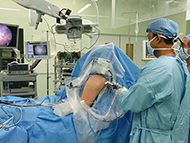How does the Shoulder joint work?
Shoulder
Rotator Cuff Tear
Rotator cuff is the group of tendons in the shoulder joint providing support and enabling wider range of motion. Major injury to these tendons may result in tear of these tendons and the condition is called as rotator cuff tear.
For more information about rotator cuff tear, click on below tabs.
Shoulder Impingement
Shoulder impingement is also called as swimmer’s shoulder, tennis shoulder, or rotator cuff tendinitis. It is the condition of inflammation of the tendons of the shoulder joint caused by motor vehicle accidents, trauma, and while playing sports such as tennis, baseball, swimming and weight lifting.
For more information about shoulder impingement, click on below tabs.
Shoulder Arthroscopy
Shoulder arthroscopy is a surgical procedure in which an arthroscope is inserted into the shoulder joint. The benefits of arthroscopy are smaller incisions, faster healing, a more rapid recovery, and less scarring. Arthroscopic surgical procedures are often performed on an outpatient basis and the patient is able to return home on the same day.
For more information about shoulder arthroscopy, click on below tabs.
Frozen Shoulder
Frozen shoulder is a condition of painful shoulder with limited movement because of pain and inflammation. It is also reffered as adhesive capsulitis and may progress to the state where an individual may feel very hard to move the shoulder.
For more information about frozen shoulder, click on below tabs.
Shoulder Joint Replacement
Shoulder joint replacements are usually done to relieve pain and when all non-operative treatment to relieve pain have failed.
For more information about shoulder joint replacement, click on below tabs.
Shoulder Instability
Shoulder instability is a chronic condition that causes frequent dislocations of the shoulder joint. A dislocation occurs when the end of the humerus (the ball portion) partially or completely dislocates from the glenoid (the socket portion) of the shoulder. A partial dislocation is referred as subluxation, whereas the complete separation is referred as dislocation.
For more information about shoulder instability, click on below tabs.
Click on the topics below to find out more from the Orthopaedic connection website of American Academy of Orthopaedic Surgeons.
- The Shoulder
- Arthritis of the Shoulder
- Broken Collarbone
- Dislocated Shoulder
- Fracture of the shoulder blade (scapula)
- Frozen Shoulder
- Rotator Cuff Tears
- Separated Shoulder
- Shoulder Impingement (Bursitis, Tendinitis)
- Shoulder Joint Replacement
- Shoulder Joint Tear (Glenoid Labrum Tear)
- Thoracic outlet syndrome
- Shoulder Arthroscopy
Mr. Vishal Sahni

Consultant Shoulder, Elbow & Hand Surgeon
MB BS, MS Orthopaedics, FRCS Surgery Glasgow, M Ch Orthopaedics Liverpool FRCS Trauma & Orthopaedics, MFSEM Sports Injuries